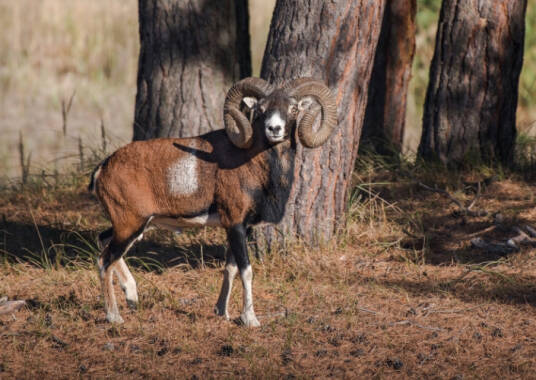Ovis gmelini
IUCN
LCBasic Information
Scientific classification
- name:Ovis gmelini
- Scientific Name:Mouflon
- Outline:Ungulata
- Family:Artiodactyla Bovidae Argali
Vital signs
- length:Shoulder height about 1 meter
- Weight:25-35kg
- lifetime:10-15years
Feature
The coat becomes thick and dense in winter and is light brown with some light grey on the back.
Distribution and Habitat
Origin: Armenia, Azerbaijan, Cyprus, Iran and Turkey.
The Asian mouflon inhabits the mountainous regions of the Zagros, western Alborz, Lesser Caucasus and central Anatolia. The species' suitable habitat includes hills, undulating terrain and gentle slopes, but also cliffs. The Asian mouflon can also live and forage in farmland.
Appearance
The males of the Asian Mouflon can weigh up to 35 kg and can be up to 1 meter tall. Females have no horns and are smaller and lighter than males, rarely weighing more than 25 kg. The coat is light brown in color and not particularly bright. The coat of the Asian Mouflon becomes heavy and dense in the winter and is light brown with some light gray on the back. There is partial black hair on the neck. In the summer, the thickness and color of the coat changes and becomes lighter so that they can cope with the heat.
Details
Ovis gmelini, English Mouflon, Asiatic Mouflon, French Mouflón, Spanish Muflón, Russian Муфлон, has 3-5 native wild subspecies: the nominate subspecies (O.g. gmelini) and two subspecies limited to Iran: Isfahan subspecies (O.g. isphahanica) and Laristan subspecies (O. g. laristanica). Sometimes the Anatolian subspecies (O. g. anatolica) and is considered a different subspecies from the nominate subspecies. However, in this assessment, the previous classification of Asiatic Mouflon subspecies (IUCN/SSC Caprinae Specialist Group 2000) is followed.

Asian mouflon is a gregarious animal. In spring and summer, the herd size is small and the sexes are often segregated. It has no territory. Generally, there are 3-5 or dozens of them in a group. It is mainly active at dawn and dusk, feeding on grass, allium and weeds, and can also live and forage in farmland.
The global population of the Asiatic mouflon may be around 26,500 (16,000 mature individuals). Population figures do not include suspected hybrids between Asiatic mouflon and Vervet's mouflon occurring in Iran. Population trends within its range are difficult to assess. While official overall figures for Iran, the main range country, indicate a stable or increasing trend (unpublished data from the Iranian Ministry of Environment 2016), local studies indicate a decrease.
Listed in the IUCN Red List of Threatened Species 2020 ver3.1 - Near Threatened (NT).
Protect wildlife and eliminate bushmeat.
Maintaining ecological balance is everyone's responsibility!








